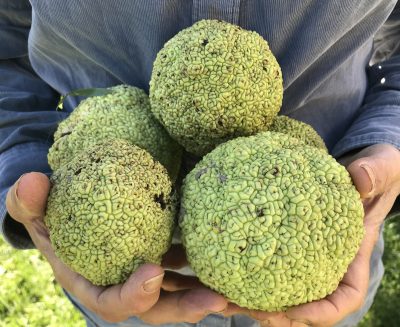Mo’ Plants
/8 Comments/in Flowers, Gardening, Planning/by Lee ReichCyclamen Addict
I’ll admit to being an addict. But my addiction — to propagating plants — is benign. It pains me to throw away an interesting seed or pruned-off stem; either can grow into a whole new plant, anything from a charming little flower to a towering tree.
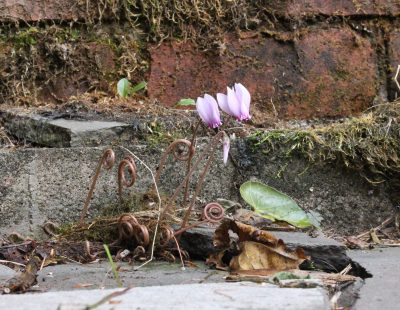
Hardy cyclamen self-sown seedling

Hardy cyclamen in pot
Case in point are some cyclamen seeds I collected and sowed a couple of years ago. The mother plant is Cyclamen hederifolium, a species that differs from the large, potted cyclamens you now see offered in garden centers, hardware stores, even supermarkets. Cyclamen hederifolium is cold-hardy here, so comes back year after years planted outdoors in the ground, and it’s a dainty plant, with small flowers and commensurately small leaves. Otherwise it looks just about the same as the widely sold commercial species, the pink or white flowers hovering like butterflies on thin stalks above the whorls of variegated leaves.
Following those flowers are seed capsules, mostly hollow balls the size of small marbles each attached to the plant by a stem that is wound up like a spring. It was in the beginning of the growing season 2 years ago that I sowed the seeds in a seed tray filled with sterilized potting mix. (I don’t usually sterilize my potting mixes but I didn’t want weeds to interfere with the slow-germinating seeds.) Eventually the seeds sprouted and I kept them watered, as needed, for good, albeit slow, growth.
Hardy cyclamen’s flowers fade and leaves melt into the ground as plants ease into dormancy with the approach of winter. Not my seedlings, though. I learned, years ago, not to push them into dormancy; instead, keep them growing as long as they want to until they’re ready to start storing energy. Which I did, with plenty of light and, as before, water as needed.
This summer, the plants were still growing — and still small — and I noticed some swelling beneath each plant. 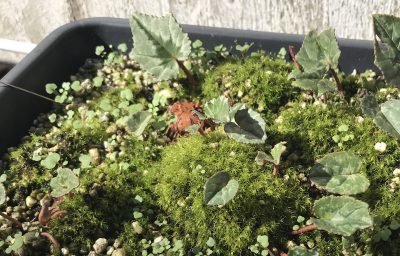 The youngsters finally were growing tubers, small bulb-like structures that will, in the future, store energy to carry the plants, dormant and leafless, through winter.
The youngsters finally were growing tubers, small bulb-like structures that will, in the future, store energy to carry the plants, dormant and leafless, through winter.
This time next year I expect my plants will be officially adult, with flowers as testimony to their maturity.
Little House Not on the Prairie
In her youth, my daughter periodically entered the world of Laura Ingalls Wilder, so the one acre, adjoining field we acquired became “the prairie.” Moving the playhouse I built out to the field would have completed the picture of “little house on the prairie.” The playhouse never got out there but the “prairie” — or “hayfield” — as I usually refer to it, has remained as such.
My affection for prairies came from my living 12 years in Wisconsin (and studying the rich soils — the richest in the world — underlying prairies). My daughter has long outgrown her prairie phase but I’m going to make my “prairie” more prairie-like. One plant for that purpose would be big bluestem (Andropogon gerardii), the star of the Big Four of grasses native to the tall grass prairies, the other three bering indiangrass (Sorghastrum nutans), switchgrass (Panicum virgatum), and little bluestem (Schizachyrium scoparium). Big bluestem is the tallest of the lot towering 6 to 10 feet high. It’s also good for hay and wildlife, and tolerates drought.
A few years ago I bought some big bluestem seeds and ended up with just a few plants. Those plants are now producing seed which — I can’t help myself — I’ve collected. 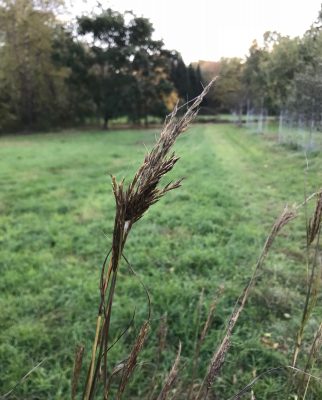 Not that some of the seeds wouldn’t self-sow near the mother plans, but seedlings that do sprout under natural conditions are subject to competition for light, nutrients, and water from other plants.
Not that some of the seeds wouldn’t self-sow near the mother plans, but seedlings that do sprout under natural conditions are subject to competition for light, nutrients, and water from other plants.
Like many fall-ripening seeds, big bluestem seeds won’t sprout as soon as they hit the ground; otherwise winter cold would do them in. So they need “stratification:” a false (or real) winter. For many seeds, cool, moist conditions, such as a few weeks residence in a mix of moist peat and perlite in a plastic bag in the refrigerator will do the trick. Big bluestem can also be coaxed out of its winter slumber with cool, dry conditions. Perhaps I’ll try both ways.
Bluestem Addiction
My present tallgrass prairie is only about 4 square feet, from two seedlings I originally planted plus their slow underground spread with rhizomes. Over time, with my additional plantings and help — a once a year, late winter mowing (taken care of under natural conditions with fire) — my prairie will swell.
A prairie takes time, as does, though less is needed, raising cyclamen to flower from seed. That time element itself brings with it certain satisfactions, both with the process and the result. That’s fortunate, since patience is an important element in successful propagation of plants.
Shaving and Composting
/17 Comments/in Design, Gardening, Pests, Soil/by Lee Reich. . . But My Garden is in Order
“Some men there are who never shave (if they are so absurd as ever to shave), except when they go abroad, and who do not take care to wear polished boots in the bosoms of their families. I like a man who shaves (next to one who doesn’t shave) to satisfy his own conscience, and not for display, and who dresses as neatly at home as he does anywhere. Such a man will be likely to put his garden in complete order before the snow comes, so that its last days shall not present a scene of melancholy ruin and decay.” So wrote Charles Dudley Warner in his wonderful little book (much more than a gardening book) My Summer in a Garden (1898). I gave up shaving a few months ago, but I am putting my garden in order for autumn.
The scene is quite pretty as I look out my upstairs bedroom window upon my garden — my vegetable garden — each morning. 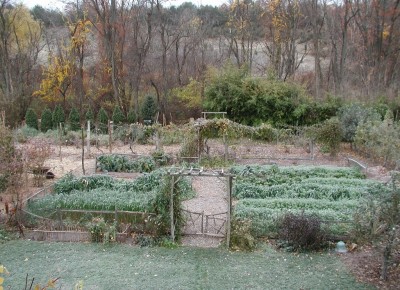 Weeds have been removed from the paths and the beds, and spent plants have been cleared away. What remains of crops is a bed with some tall stalks of kale that were planted back in spring. Yet another bed is home to various varieties of lettuce interplanted with endive, all of which went in as transplants after an early crop of green beans had been cleared and the bed was weeded, then covered with an inch depth of compost. Also still lush green is a bed previously home to edamame, which was subsequently weeded, composted, and then seeded with turnips and winter radishes back in August.
Weeds have been removed from the paths and the beds, and spent plants have been cleared away. What remains of crops is a bed with some tall stalks of kale that were planted back in spring. Yet another bed is home to various varieties of lettuce interplanted with endive, all of which went in as transplants after an early crop of green beans had been cleared and the bed was weeded, then covered with an inch depth of compost. Also still lush green is a bed previously home to edamame, which was subsequently weeded, composted, and then seeded with turnips and winter radishes back in August.
From my window, the remaining eight beds in the garden present mostly grasses in various states of lushness. The “grass” in this case is oats, sown in any bed no longer needed for vegetables at the end of this season. I had cleared such beds of spent plants and weeds, sprinkled oat seeds (whole “feed oats” from Agway), watered, and then, as with the other beds, covered them with an inch depth of compost. One bed was finished for the season except for six floppy cabbage plants. I staked those plants up tall and out of the way, and then gave the bed the same treatment around the cabbages’ ankles.
Ready for Spring
That’s it: It all looks fresh, green, and neat — but more than that, what I did is also good for next year’s garden. Cleaning up weeds this year makes for less self-seeding of annual weeds and seeding and establishment of perennial weeds. Cleaning up spent plants takes any pest-ridden plant parts off-site, reducing chances for future pest problems.
Dense growth of oats protects the soil surface from pounding rain so water percolates in rather than skittles off the surface, promoting erosion. 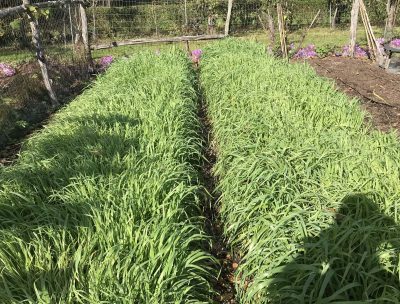 Below ground, oat roots pull up nutrients that rain and snow might otherwise leach away into the groundwater.
Below ground, oat roots pull up nutrients that rain and snow might otherwise leach away into the groundwater.
And finally, that inch depth of compost that each bed gets helps support the many beneficial fungi, bacteria, actinomycetes, and other soil microorganisms that make up the soil food web. In so doing, it will provide ALL the nutrition my vegetable plants, even intensively planted vegetables, need until this time next year.
Mr. Warner, I think, would approve. Even my non-shaving; I do trim my beard regularly.
Add Water, Conveniently
A lot of compost is needed to cover all those vegetable beds. For all the beds in my two vegetable gardens, as well as those in my greenhouse, I estimate my annual needs at almost 5 cubic yards per year.
My compost is made from hay I scythe from my small field, kitchen scraps, spent vegetable plants and weeds from my garden, some horse manure in wood shavings, and, for fun, old cotton or woolen clothing, and leather gloves and shoes.
Yes, I’ve read about striking a balance between feedstuffs high in carbon and those high in nitrogen in order to get a compost pile chugging along. As important is good aeration and moisture. Most compost piles that I see suffer from thirst.
A lot of water is required to wet the inner layers of a compost pile, and applying it requires more patience than I have. So I no longer do it manually.
I purchased a small sprinkler which I connected with 1/2” black plastic tubing (the same as I use for drip irrigation mainlines) along with some L connectors to lead the water line from the top center of a pile neatly down to ground level. Water pressure is variable from my well so I also put a pressure reducer, to 15 psi, in the line; a valve needing just one-time adjustment keeps the sprinkler wetting only the top of the pile. A U-shaped metal pin keeps the sprinkler firmly in place in the center of the pile.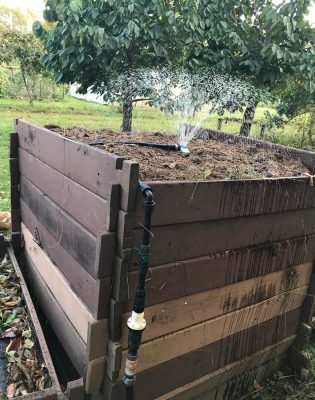
All that’s needed after adding a batch of material to the pile is to set up the sprinkler, turn on the spigot, and set a timer for about 20 minutes. The droplets cover the pile right to the edges and in a day or two temperatures soar to 140° or more.
Next year at this time, this year’s piles will be ready to do their part in putting my garden neat and in order.
Fiery Colors
/4 Comments/in Gardening/by Lee ReichColorful Predictions
As leaves are just starting to color up, the question is, “Will the autumn leaf show be good this year?” First off, whether or not it’s good, global warming has pushed showtime forward a bit each year. Around here, the peak of the show used to be the middle of October; nowadays it’s the third week in October.
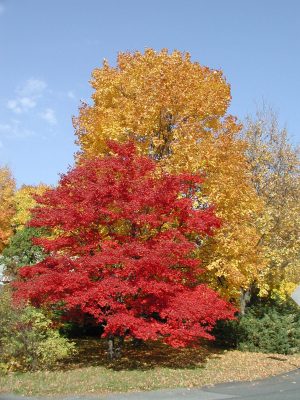
Japanese and sugar maples
Back to predicting how good the show will be this year . . . Throughout summer and into autumn most leaves are, of course, green, which is from chlorophyll. Chlorophyll must be continually synthesized for a leaf to stay green. The shorter days and lowering sun of waning summer are what trigger leaves to stop producing it, letting other pigments lurking there out of hiding.
The yellow and orange colors of leaves are always lurking there, thanks to carotenoid pigments, which help chlorophyll do its job of harvesting sunlight to convert into plant energy. I offer thanks to carotenoids for the especially warm, yellow glow they give to gingko, aspen, hickory, and birch leaves.
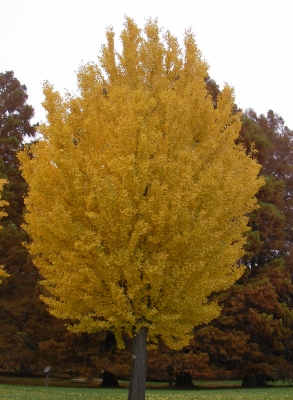
Gingko
Tannins are another pigment, actually metabolic wastes, that all summer are hidden by chlorophyll. Their contribution to the fall palette are the season’s subdued browns, notable in some oaks and enriching the yellow of beeches.
Because leaves harbor carotenoids and tannins all summer long, nothing particular about autumn weather should either intensify or subdue their autumn show. The only glitch could be an early, hard freeze that occurs while leaves are still chock full of chlorophyll. In that case, cell workings come screeching to a halt and all that’s left are frozen, green leaves that eventually drop without any fanfare.
Autumn color also spills out reds and purples, most evident in red maples and some sugar maples, scarlet oak, sourwood, blueberry, and winged euonymus. Those reds and purples come from yet another pigment, anthocyanins. Except for trees like ‘Purple Fountain’ beech and ‘Royal Purple’ smokebush, whose leaves unfold dusky red right from the get go in spring and remain so all season long, in most leaves anthocyanins do not begin to develop until autumn.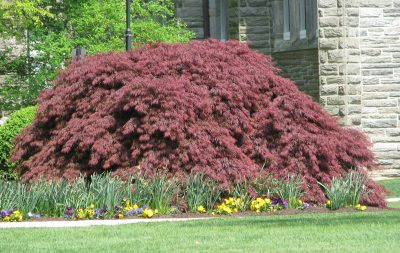
Anthocyanin formation requires sugars, so anything that we or the weather does to promote sugar accumulation in autumn will increase anthocyanin levels in leaves. Ideal weather conditions for sugar accumulation are warm, sunny days to maximize photosynthesis, and cool, but not frigid, nights to minimize nighttime burning up of accumulated sugars.
The many cloudy and rainy days for the past weeks don’t bode well for a great autumn show of leaf color. Less red because less anthocyanin is formed, and any that does form is diluted.
Our Hand in the Color Palette
Weather plays its part in autumn color but we can also have a hand in its development. One way is to ratchet up the reds and purples to make sure that leaves bask in light. I plant a tree where light is adequate (for that species) and, as necessary, prune so that branches don’t shade each other. Street lights don’t count as light, and actually have a negative effect, disrupting the signal that days are getting shorter and it’s time to slow chlorophyll production.
We also can ramp up the autumn show by planting trees genetically programmed for good autumn color. Among the most colorful-leaved trees and shrubs—which, besides those previously mentioned, include goldenrain tree, hickory, ironwood, black tupelo, and fothergilla—individuals within each species might pack a bigger wow than the others. Hence the spicebush variety ‘Rubra’, brick red in fall, or ‘Wright Brothers’ sugar maple, whose leaves become a mottling of gold, pink, orange, and scarlet.
Admittedly, the weather trumps (sorry) all.
(For more about some of the science going on behind the scenes in your garden, and how to put it to practical use, see my new book, The Ever Curious Gardener: Using A Little Natural Science for a Much Better Garden, from which the above is adapted.)
A Brainy Orange
There’s another orange in the garden this autumn, and it’s not in the leaves or the fruit — the hardy orange — about which I recently wrote. It’s the osage orange (Maclura pomifera).
I grew my two trees from seeds extracted from a local osage orange I found on the ground. Each tree is about 25 feet tall and intimidating for their large, mean thorns. Trees are either male or female, so I lucked out, ending up with one of each, allowing the female to bear.
Why would I plant such a tree? For interest: This native of the midwest was, thanks to its thorns, a predecessor of barbed wire for containing livestock; also the primo wood sought after by Native Americans for their bows; and the wood is among the most rot-resistant of any tree.
The softball-sized fruit also is very interesting, with all its convolutions looking something like a green brain. Although related to fig and mulberry, it’s not at all edible. The fruit is claimed, without substantiation, to repel insects and spiders in and around homes.